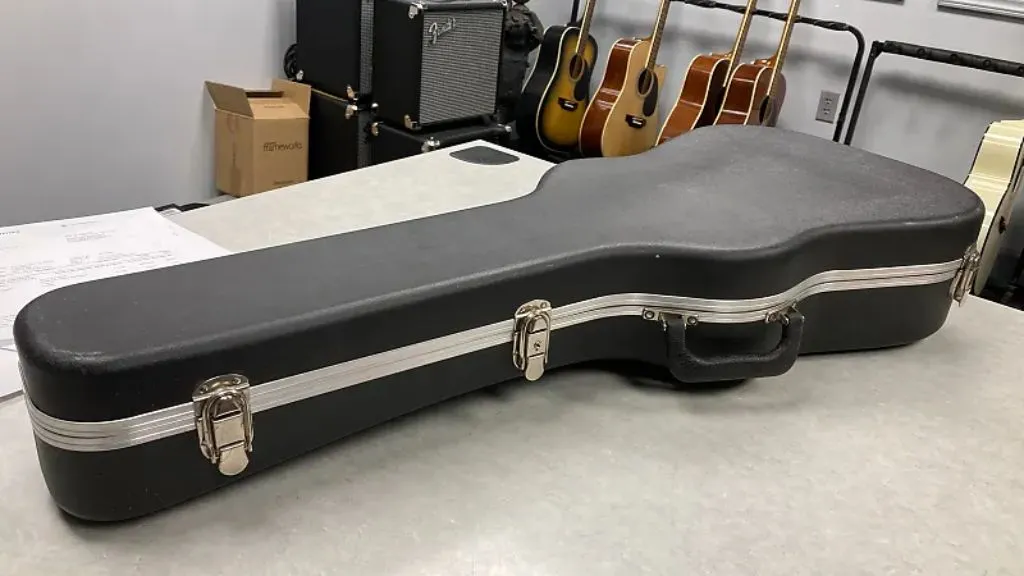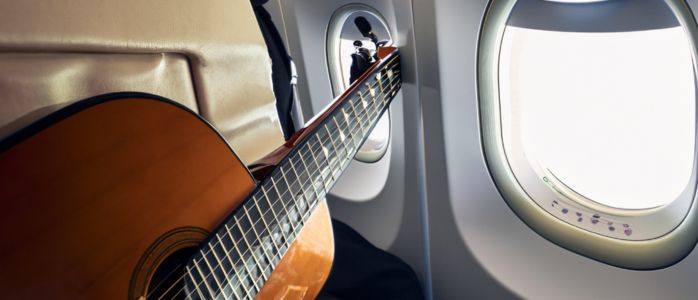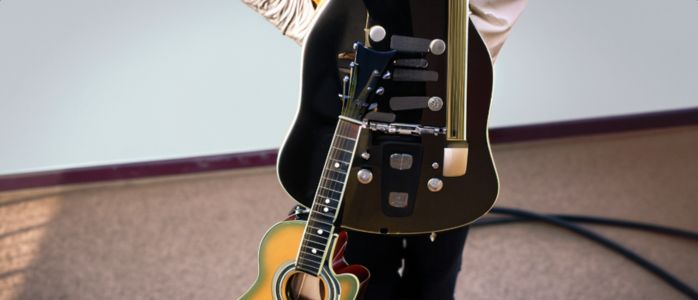Can You Bring A Guitar On A Plane? Travel With Guitar

Can you bring a guitar on a plane has become a common query among musicians. They eagerly seek to showcase their talents even on distant shores. Fortunately, taking a guitar on a plane is generally permitted, but with certain guidelines & precautions.
Many airlines consider guitars as carry-on items. Allowing passengers to bring them into the cabin as long as they adhere to specific size and weight restrictions. Carrying things like electronics on a plane.
It is advisable to check with the airline beforehand and review their policies to ensure compliance. Protecting the guitar is essential, and using a sturdy, well-padded case is recommended to safeguard it from potential damage.
Loosening the strings or detaching the neck might help minimize tension-related issues caused by changes in temperature & pressure. While it is essential to exercise caution. The joy of strumming melodies in various destinations remains within reach, as the sky welcomes guitarists on their musical journeys.
TSA Rules On Can You Bring A Guitar On A Plane?
When it comes to travelling with a guitar, understanding the TSA rules is crucial to ensure a smooth and hassle-free experience. Get an in-depth overview of the TSA regulations surrounding flying with a guitar. Covering various aspects from packing to security procedures.
Carry-on or Checked Baggage
The first consideration is whether to bring the guitar carry on plane or checked baggage. While many airlines allow passengers to bring guitars as carry-on items. It is important to check with the specific airline’s policies beforehand.

You must inform the TSA officer in case your guitar needs special care & handling. Not only guitar but other stuff as well like bringing speakers on a plane in your luggage. Generally, carrying a guitar in the cabin is preferred as it minimizes the risk of damage during transit.
Size and Weight Restrictions
Most airlines have specific size and weight restrictions for carry-on items, including musical instruments. The TSA does not set specific guidelines for guitars, but it is advisable to adhere to the airline’s policies.
Typically, full-sized guitars can fit in overhead compartments, but smaller instruments like ukuleles may be stowed under the seat. It is essential to measure and ensure the guitar’s dimensions comply with the airline’s requirements. If you are bringing other big equipment like strollers on a plane with luggage, you must check its size as well.
Protective Case
Investing in a sturdy and well-padded case is crucial to protect the guitar from potential damage. A hard-shell case provides the best protection against impacts and external pressure.
Soft gig bags, although lightweight and convenient, offer less protection. Ensure the case is properly latched or locked to prevent accidental openings. If you are bringing some other fragile item like glass on a plane in carry-on luggage, make sure to use a protective case or packaging for it as well.
Security Checkpoints
Passing through security checkpoints with a guitar requires careful handling. When approaching the security scanner, remove the guitar from its case and place it in a separate bin. This allows the TSA agents to get a clear view of the instrument and prevents any confusion or delays.
Other things like the battery pack on a plane will be checked as well. Remember to keep an eye on your guitar as it goes through the scanner to ensure it is handled with care.
Detuning or Loosening Strings
Guitars are susceptible to changes in temperature and pressure during flight, which can affect the tension on the strings. To mitigate the risk of damage, it is recommended to loosen or detune the strings slightly before the flight.
This helps alleviate the stress on the neck and reduces the chances of strings snapping due to increased tension.
Documentation
While not mandatory, carrying documentation such as receipts or proof of ownership for the guitar can be helpful. Especially for expensive or vintage instruments.
This documentation can assist in establishing ownership and value in case of loss or damage. It is advisable to make copies of important documents and keep them separate from the originals.
International Travel Considerations
When travelling internationally, it is crucial to research and comply with the customs regulations of both the departure and arrival countries. Some countries may have specific requirements for bringing musical instruments. Including the need for permits or certificates.
Researching ahead of time and contacting the respective embassies or consulates can provide valuable information. Regarding any necessary documentation or procedures.
Traveling With A Guitar: Types Of Guitar Cases
When it comes to protecting your beloved guitar, a sturdy and reliable case is essential. Guitar cases come in various types, each offering different levels of protection and functionality. Let’s explore some of the most common types of guitar cases available on the market.
Hardshell Cases

Hardshell cases are widely regarded as the gold standard when it comes to guitar protection. Constructed with a rigid outer shell, usually made of wood or moulded plastic. These cases offer excellent durability and impact resistance.
They provide a high level of protection against bumps, drops, and other mishaps during transportation. Hardshell cases often feature plush interiors and secure latches to keep your guitar snug and secure.
They are available in various sizes to accommodate different guitar shapes, such as dreadnought, classical, or electric.
Gig Bags
It’s also known as soft cases or padded bags, are lightweight and offer a convenient option for musicians on the move. They are made of durable fabric and feature ample padding to protect the guitar from scratches and minor impacts.
Gig bags typically have shoulder straps and handles for easy carrying. Along with multiple pockets to store accessories like strings, picks, and cables. Gig bags are popular among musicians who value portability and need a practical solution for short trips or gigs.
Hybrid Cases
As the name suggests, hybrid cases combine the features of both hardshell and gig bags. Offering a balance between protection & portability. These cases often feature a rigid exterior similar to a hardshell case, ensuring good impact resistance.
While incorporating padded interiors like gig bags to provide added cushioning. Hybrid cases may also include backpack straps for easy carrying.
Making them a versatile option for musicians who require a higher level of protection than a gig bag. But prefer a lighter and more flexible solution compared to a traditional hardshell case.
Flight Cases
Flight cases, also referred to as ATA (Air Transport Association) cases. They are specifically designed for heavy-duty protection during air travel or other rigorous touring scenarios. These cases are constructed with an extremely rugged exterior, typically made of aluminium or composite materials.
They are reinforced corners to withstand rough handling. Flight cases often feature custom foam interiors that are precisely cut to fit the specific guitar model. Providing maximum shock absorption and stability.
While flight cases offer unparalleled protection. They tend to be bulkier and heavier than other options. Making them more suitable for professional musicians or those with valuable vintage instruments.
Semi-Hollow and Hollow Body Cases
Semi-hollow and hollowbody guitars, known for their unique shapes and sizes, require specialized cases that accommodate their specific designs. These cases are typically larger and have a shape that corresponds to the guitar’s body shape. Providing a snug fit and optimal protection.
They may also include additional padding and support to prevent any potential damage to the delicate F-holes or center block. If you own a semi-hollow or hollow body guitar.
It is crucial to invest in a case specifically designed for these types of instruments to ensure proper protection during transit.
Tips On Flying With A Guitar

Flying with a guitar can be a nerve-wracking experience for musicians. But with some careful planning and preparation, you can ensure a smooth journey for your instrument. Here are some essential tips to keep in mind when traveling with a guitar:
- Check Airline Policies: Before booking your flight, thoroughly review the airline’s policies regarding musical instruments. Some airlines may have specific regulations or fees associated with carrying instruments on board. If you are carrying other things like a drone on a plane, make sure to check policies for it too. Ensure that your guitar meets the size and weight restrictions for carry-on or checked baggage.
- Use a Sturdy Case: Invest in a high-quality, well-padded guitar case that provides adequate protection. A hardshell case is generally recommended for maximum security. But if you prefer a lighter option, consider a hybrid case. Ensure that the case is properly fitted to your guitar to prevent any movement or potential damage during transit. If carrying glass bottle liquor on a plane in a carry-on bag, make sure to use the best case to keep it.
- Loosen the Strings: Loosen the tension of your guitar strings slightly. It will relieve the pressure caused by changes in temperature and altitude. This can help prevent the strings from snapping or causing damage to the neck of the guitar.
- Carry-On vs. Checked Baggage: Whenever possible, try to bring your guitar as a carry-on item and store it in the overhead compartment. This allows you to keep an eye on your instrument and reduces the risk of mishandling by airport personnel. However, if your guitar is too large or the airline doesn’t allow it as carry-on, you may need to check it as fragile baggage. Make sure to add extra layers of protection within the case, such as bubble wrap or clothing, to cushion any potential impacts.
- Inform the Cabin Crew: Once you board the plane, inform the cabin crew that you are carrying a fragile musical instrument.
- Purchase Additional Insurance: Consider obtaining additional insurance coverage for your guitar, especially if it is valuable or irreplaceable.
- Document the Guitar’s Condition: Take detailed photos of your guitar before your flight.
- Be Prepared for Security Checks: When going through airport security, inform the security officers that you have a guitar. This follows for other items too like carrying alcohol on a plane in a carry-on bag.
- Consider a Humidity Control Device: If you are travelling to a destination with significantly different humidity levels. Consider using a humidifier or dehumidifier device inside your guitar case to protect it from excessive moisture or dryness.
Can I Carry On A Guitar: How To Pack A Guitar?
To pack a guitar before travelling on a plane, start by loosening the strings to relieve tension. Next, place a soft cloth or bubble wrap over the guitar’s body and secure it with tape or rubber bands. Place additional padding around the headstock and bridge area.

Place the guitar in a well-padded hardshell or hybrid case, ensuring a snug fit. Add extra cushioning around the sides and bottom of the case, using foam, clothing, or bubble wrap.
Secure the case latches and lock if available. Attach a “fragile” tag to the case & consider wrapping the case in a plastic bag for added protection against moisture.
Remember to follow airline guidelines for carry-on or checked baggage. Consider purchasing additional insurance for peace of mind. If you are looking on how to pack other things like crystals on a plane, you must check it to make a hassle-free journey.
How To Take A Guitar On A Plane?
To take a guitar on a plane, start by checking the airline’s policies regarding musical instruments. If it’s allowed to bring guitar carry on plane, invest in a sturdy, well-padded guitar case that meets size restrictions.
Loosen the strings slightly to relieve tension during changes in altitude. Arrive early at the airport and inform the cabin crew about your guitar.
If it needs to be checked, add extra layers of protection within the case and consider purchasing additional insurance. Document the guitar’s condition with photos. During security checks, inform officers about the instrument.
Finally, consider using a humidifier or dehumidifier device to protect against changes in humidity. By following these steps, you can safely bring your guitar on a plane and enjoy making music wherever your travels take you.
Conclusion
In conclusion for the question, can you bring a guitar on a plane is generally allowed, subject to airline policies. Using a sturdy case, loosening strings, and being aware of security procedures are essential.
Whether as carry-on or checked baggage, proper protection and documentation ensure a safe journey for your instrument. By following guidelines and preparing in advance, you can enjoy the thrill of playing your guitar wherever your travels may take you.
Frequently Asked Questions
Got questions about can I bring a guitar on a plane, like- can a guitar be a carry on? Look no further. In this FAQ, we’ll address common concerns, guidelines, and tips to help you navigate the process of travelling with your instrument.
Yes, in many cases, you can bring a guitar on a plane as a carry-on item. Most airlines consider guitars as allowable carry-on items, as long as they meet size and weight restrictions.
Size and weight restrictions for carrying a guitar on a plane vary by airline. Typically, the maximum dimensions for a carry-on item are around 22 x 14 x 9 inches (55 x 35 x 23 cm).
If your guitar doesn’t meet the size requirements for carry-on items, or if you prefer to check it as baggage, you may do so.
Check airline policies, use a sturdy case, loosen strings, inform crew. Add protection if checking, document condition, inform security, consider humidity control.
In most cases, you do not need to purchase an extra seat for your guitar. Guitars can typically be accommodated as carry-on items or checked baggage.
To travel with a guitar you must contact the particular airline to get all the details on it. They will tell you all the special instructions on it.
If airport security wants to inspect your guitar, remain calm and cooperative. Inform them that you have a fragile musical instrument and follow their instructions.
Yes, you can bring your guitar on an international flight. But it’s important to be aware of the specific regulations and restrictions of both your departure and destination countries.





Comments